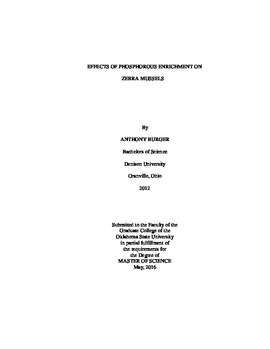| dc.contributor.advisor | Dzialowski, Andrew | |
| dc.contributor.author | Burger, Anthony | |
| dc.date.accessioned | 2017-02-22T22:14:01Z | |
| dc.date.available | 2017-02-22T22:14:01Z | |
| dc.date.issued | 2016-05-01 | |
| dc.identifier.uri | https://hdl.handle.net/11244/49055 | |
| dc.description.abstract | Cultural eutrophication has decreased overall water quality and increased the occurrence and intensity of cyanobacteria blooms. Eutrophication may interact with other stressors such as invasive species. Zebra mussels (Dreissena polymorpha) are an invasive species causing severe ecological and economic impacts. Zebra mussels are effective filter feeders on phytoplankton, causing top down control and redistributing nutrients from pelagic to benthic environments. It is less well known how zebra mussels affect aquatic food webs along a gradient of eutrophication. The objective of this research was to better understand the interactions between eutrophication and invasive zebra mussels. I conducted a series of mesocosm experiments to determine how phosphorus additions interacted with zebra mussels and influenced zebra mussel feeding rates. An outdoor mesocosm experiment tested if phosphorous enrichment and zebra mussels affected water quality and plankton. In an established phosphorous gradient, phosphorus had a significant effect on chlorophyll a but not zebra mussels. Cyanobacterial (measured as phycocyanin) biomass was affected by the interaction of phosphorus and zebra mussels. Cladoceran abundance increased with increasing phosphorus but decreased in mussel treatments. Copepod abundance also increased with phosphorus, but was not affected by zebra mussels. An indoor mesocosm experiment tested how zebra mussels were affected by phosphorus concentration in their algal resources. Zebra mussel filtering rates significantly decreased with increasing phosphorus enrichment. The feeding rate for low (no phosphorus) and medium (520 �g/L phosphorus) each differed from the very high treatment (5,200 �g/L) though this concentration is not likely to occur in natural settings. The findings of these two studies suggest that zebra mussel effects may not be as strong as suspected and that nutrients are a stronger driver than zebra mussel consumption in terms of algal biomass. Although mussel feeding was constrained at very high phosphorus, it only occurred at concentrations that are not biologically relevant. | |
| dc.format | application/pdf | |
| dc.language | en_US | |
| dc.rights | Copyright is held by the author who has granted the Oklahoma State University Library the non-exclusive right to share this material in its institutional repository. Contact Digital Library Services at lib-dls@okstate.edu or 405-744-9161 for the permission policy on the use, reproduction or distribution of this material. | |
| dc.title | Effects of Phosphorous Enrichment on Zebra Mussels | |
| dc.contributor.committeeMember | Jeyasingh, Punidan | |
| dc.contributor.committeeMember | Long, James | |
| osu.filename | Burger_okstate_0664M_14645.pdf | |
| osu.accesstype | Open Access | |
| dc.description.department | Zoology | |
| dc.type.genre | Thesis | |
| dc.type.material | text | |
